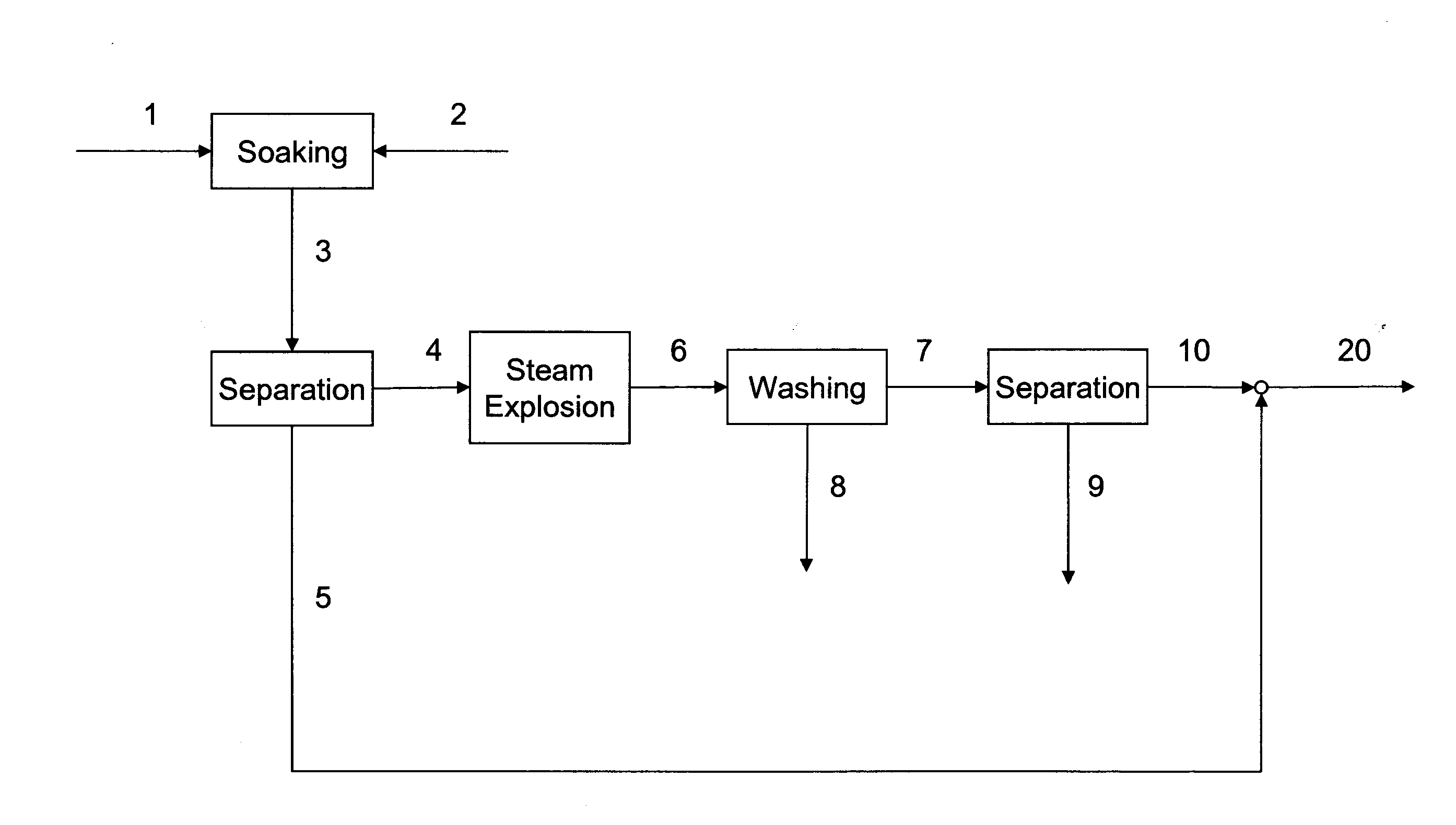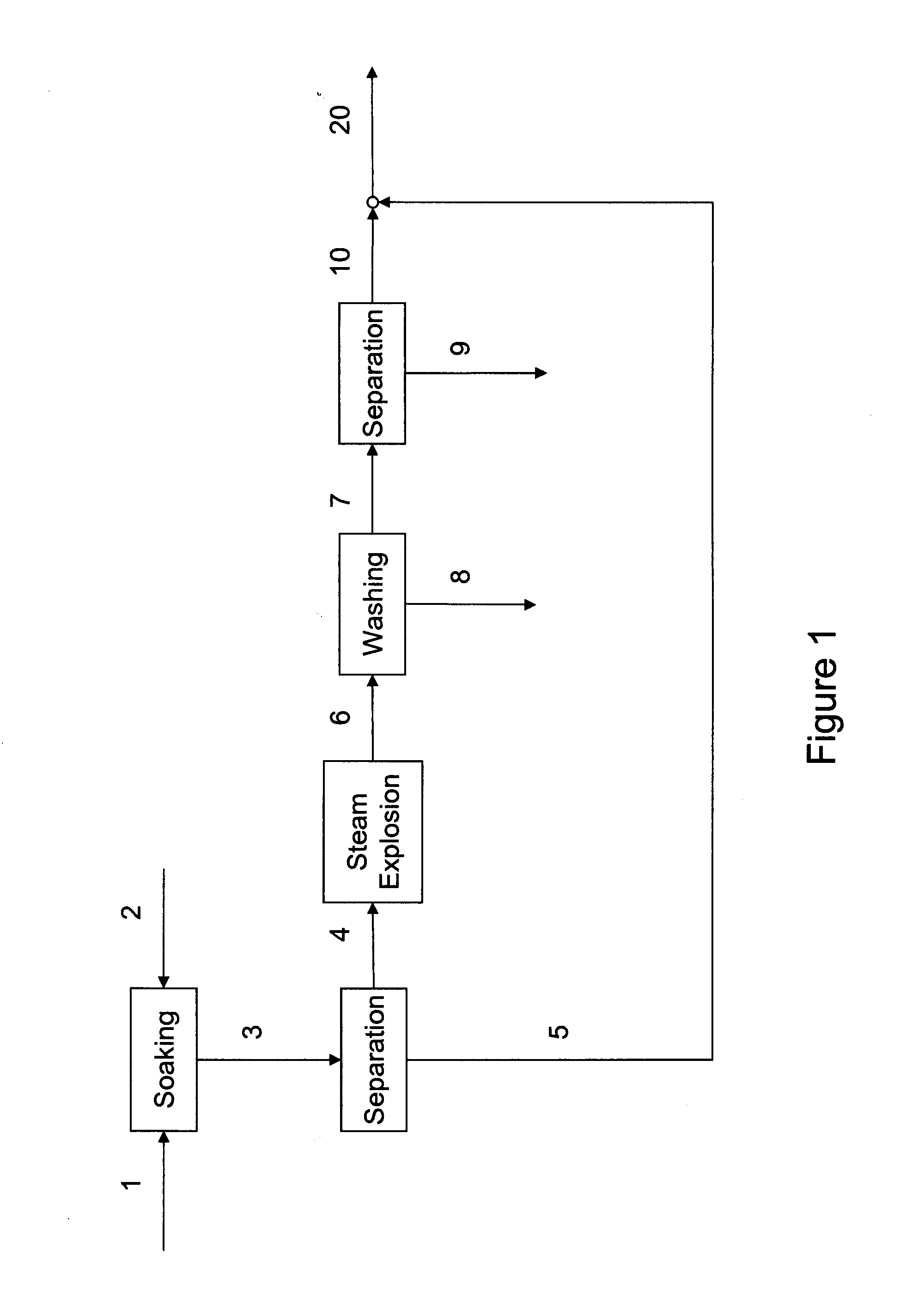Biomass pretreatment process
a pretreatment process and biomass technology, applied in the direction of cellulose treatment using microorganisms/enzymes, other chemical processes, applications, etc., can solve the problems of reducing yield, reducing yield, and complex hemicellulytic system
- Summary
- Abstract
- Description
- Claims
- Application Information
AI Technical Summary
Benefits of technology
Problems solved by technology
Method used
Image
Examples
example 1
[0106]Arundo has the following composition: 37.5% glucans, 19.3% xylans, 5.8% acetyl groups, 22.6% Klason lignin 6.3% ash, 8.5% extractives.
[0107]Arundo was submitted to continuous steam explosion (Stake Tech reactor) at 200° C. for 6 minutes. This pretreatment lead to a solubilisation of 70.6% of xylan and 8.6% of glucan. A 19.3% of xylan were degraded to inhibitor compounds (furfural and other degradation product), and 1.9% of glucans were degraded to inhibitors compounds (HMF and formic acid)
[0108]An amount of pretreated material which composition can be summarized in solvent, soluble solid, insoluble solid, is added to a laboratory fermenter. Solvent (water, buffer, antibacterial solution) and catalyst solution are added to this material in order to reach a total solid content of 7.5%. Catalysts solution is calculated to have an activity of 60 FPU / g glucans and 109 FXU / g xylan for pretreated Arundo.
[0109]The composition of the stream entering the enzymatic hydrolysis is shown i...
example 2
[0113]Arundo has the following composition: 37.5% glucans, 19.3% xylans, 5.8% acetyl groups, 22.6% Klason lignin 6.3% ash, 8.5% extractives.
[0114]Arundo was submitted to continuous steam explosion (Stake Tech reactor) at 215° C. for 6 minutes. This pretreatment lead to a solubilisation of 90.8% of xylan and 7.1% of glucan. A 63.8% of xylan were degraded to inhibitor compounds (furfural and other degradation product), and 4.5% of glucans were degraded to inhibitors compounds (HMF and formic acid)
[0115]An amount of pretreated material which composition can be summarized in solvent, soluble solid, insoluble solid, is added to a laboratory fermenter. Solvent (water, buffer, antibacterial solution) and catalyst solution are added to this material in order to reach a total solid content of 7.5%. Catalysts solution is calculated to have an activity of 60 FPU / g glucans and 248 FXU / g xylan for pretreated Arundo.
[0116]The composition of the stream entering the enzymatic hydrolysis is shown i...
example 3
[0121]Fiber sorghum has the following composition: 35.8% glucans, 20.0% xylans, 5.61% acetyl groups, 17.3% Klason lignin 6.4% ash, 14.8% extractives.
[0122]Chopped sorghum was submitted to continuous steam explosion (Stake Tech reactor) at 200° C. for 6 minutes. This pretreatment lead to a solubilisation of 86.6% of xylan and 25.5% of glucan. A 61.7% of xylan were degraded to inhibitor compounds (furfural and other degradation product), and 8.0% of glucans were degraded to inhibitors compounds (HMF and formic acid)
[0123]An amount of pretreated material which composition can be summarized in solvent, soluble solid, insoluble solid, is added to a laboratory fermenter. Solvent (water, buffer, antibacterial solution) and catalyst solution are added to this material in order to reach a total solid content of 7.5%. Catalysts solution is calculated to have an activity of 60 FPU / g glucans and 220 FXU / g xylan for pretreated Sorghum.
[0124]The composition of the stream entering the enzymatic h...
PUM
| Property | Measurement | Unit |
|---|---|---|
| Temperature | aaaaa | aaaaa |
| Temperature | aaaaa | aaaaa |
| Time | aaaaa | aaaaa |
Abstract
- A) Soaking a ligno-cellulosic biomass feedstock in vapor or liquid water or mixture thereof in the temperature range of 100 to 210° C. for 1 minute to 24 hours to create a soaked biomass containing a dry content and a first liquid;
- B) Separating at least a portion of the first liquid from the soaked biomass to create a first liquid stream and a first solid stream; wherein the first solid stream comprises the soaked biomass; and
- C) Steam exploding the first solid stream to create a steam exploded stream comprising solids and a second liquid.
Description
Claims
Application Information
 Login to View More
Login to View More - R&D
- Intellectual Property
- Life Sciences
- Materials
- Tech Scout
- Unparalleled Data Quality
- Higher Quality Content
- 60% Fewer Hallucinations
Browse by: Latest US Patents, China's latest patents, Technical Efficacy Thesaurus, Application Domain, Technology Topic, Popular Technical Reports.
© 2025 PatSnap. All rights reserved.Legal|Privacy policy|Modern Slavery Act Transparency Statement|Sitemap|About US| Contact US: help@patsnap.com



